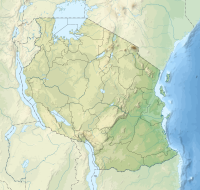The Dar es Salaam Marine Reserve System or DMRS (Hifahdi Akiba Bahari ya Dar es Salaam, in Swahili) is a group of marine reserves in Tanzania, with the IUCN category II located within Dar es Salaam Region of Tanzania. [1] The reserve system consists of nine uninhabited islands, four located north of Dar es Salaam's Kinondoni District; (Bongoyo, Mbudya, Pangavini and Fungu Yasini) and four south of the city Makatumbi Islands, Kimbubu Island, Sinda Island and Kendwa Island in Kigamboni District. It provides protection for several important tropical ecosystems; coral reefs, mangroves and seagrass beds.[2]
| Dar es Salaam Marine Reserve System | |
|---|---|
| (DMRS) | |
 Mbuya Island beach of the DMRS | |
| Location | Dar es Salaam Region, Kinondoni District |
| Nearest city | Dar es Salaam |
| Coordinates | 06°50′S 39°25′E / 6.833°S 39.417°E |
| Area | 15 km² |
| Established | 1975 |
| Governing body | Marine Parks & Reserves Authority (Tanzania) |
| Website | DMRS |
Legal status edit
Management of the reserve is governed by the Tanzanian Board of Trustees of Marine Parks and Reserves which is the custodian and overseer of the establishment and management of the Marine Protected Reserves in Tanzania.
The Dar es Salaam Marine Reserves were first established under the Fisheries Act of 1970 and in 1998 were transferred to the Marine Parks and Reserves [1] (MPRs), Act No. 29 of 1994. [2].
Threats edit
Visits to the reserve area (especially Bongoyo and Mbudya) are a popular daytrip for both tourists and Tanzanian residents alike, the islands serving as a location for a variety of leisure activities, including snorkelling, sunbathing and hiking. However, over recent years unregulated tourist activities has led to degradation within the reserves.
The nearby fishing communities of Kunduchi, Unonio, and Msasani all appear to be heavily dependent on the resources in the reserves [3] and resource over-exploitation is an increasing concern with local fishermen attributing a decline in fish catches over recent years to the use of small mesh nets and dynamite fishing. A decrease in the abundance of fish and coral health, and an increased amount of bleached and broken coral has been noted by divers.
Coconut Crabs edit
On Tanzania's mainland, it appears that there are hardly any populations left, while it's likely that a few remain to the north of Dar es Salaam. In contrast, the Dar es Salaam Marine Reserve system is made up of nine tiny, uninhabited islands, six of which are known to have colonies of coconut crabs (Mbudya, Bongoyo, Pangavini, Kendwa, Sinda Island). Bongoyo Island had the largest specimes of the crabs in the country.[3]
External links edit
- Website of Marine Parks and Reserves of Tanzania, very poor on information
- Special report by the Tanzania Marine Parks and Reserves Unit (MRRU, 2012)[permanent dead link]
References edit
- ^ Levine, Arielle. (2010). Local Responses to Marine Conservation in Zanzibar, Tanzania. Journal of International Wildlife Law and Policy. July–December 2004. 183-202. 10.1080/13880290490883241
- ^ "Dar Es Salaam Marine Reserve System". Retrieved 19 May 2023.
- ^ Caro, Tim, et al. "A case study of the coconut crab Birgus latro on Zanzibar highlights global threats and conservation solutions." Oryx 55.4 (2021): 556-563.
